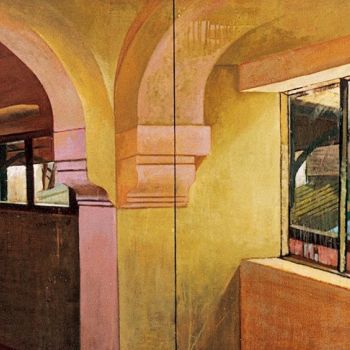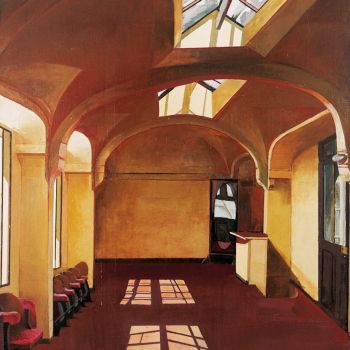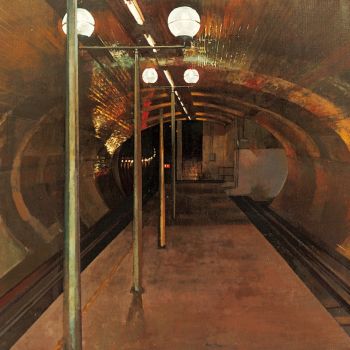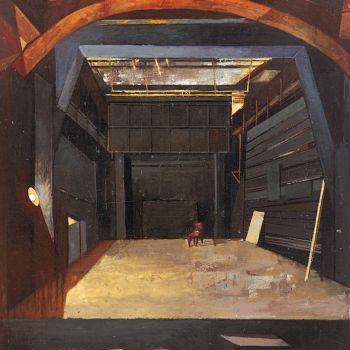When Irini started painting in her small room, at the 14th arrondissement of Paris, she made her first steps by describing a familiar world. The four walls amongst which she spent most of her days became her canvas; the very background in which she displayed all kinds of everyday life objects and ephemera: armchairs, boxes, umbrellas, easels, stretchers and canvases and even some figures of angels bought in flea markets. Everything was carefully and earnestly drawn. The perspective was correct and the colours, sensual. At first, one could easily imagine that Irini was contented with a realistic depiction of her objects.
However, a second, more thorough lecture of this charming little universe of hers could immediately change the beholder‘s mind. Even if all the objects seemed placed on the right position, even if everything seemed tidy, an odd, internal vibration seemed to break this overall calmness. Angels and objets seemed to be moving in a mysterious, transitional space, where, sooner or later, they could be transformed by a sort of metaphysical power, just like the one reigning in De Chirico‘s paintings. This metaphysical dimension is very much relevant to a surrealistic perspective of reality and became for Irini the epicentre of a constant search. This is the reason why, when she left this little room which was full of the metaphysical traps of a very personal imaginary space, fortune brought her to different environments, enriched with a unique imaginary presence, which opens up to dreams and nostalgy.
The first space the artist came across were the premises of an old, abandoned theatre at Rue du Vieux Colombier. It was a small, elegant theatre space, with a main hall, a stage, some fancy woodwork, armchairs with red velvet upholstery, a lobby surrounded by smaller rooms and corridors, dressing rooms with windows, dormer windows, stained glass windows and mirrors, all left in total abandonment, but also veiled by the enchanted presence of a distant past. Under its torn fabrics, on its scratched walls, one could feel the transitory presence of thousands of people, who gathered by chance and were left to enjoy the magic of a theatre play.
The artist was promptly charmed by the peculiar atmosphere of this space. Every single corner of it becomes a theatre and a scenery; every glimpse of light becomes a spotlight. She chooses bigger canvases, in order to make this continuum of halls and spaces fit in two dimensions. She creates wider perspectives, architecturally organising her canvas.
Her need to focus on every single detail, to mention every object, creates complex, narrative images. Natural daylight reaches easily all the peripheral corridors, but the artist prefers the artificial, electric light, which covers the forms with a seducing veil of mystery.
The painting absorbs one‘s eye, leading it through a labyrinth of narrow paths, doors and arches, boxes and rows of theatre seats, until it loses its sense of orientation and starts wandering and daydreaming.
The stage becomes Irini‘s favourite place. She perceives it as the most dramatic spot in a theatre. Bare, free of any decorations or settings, with plain wooden boards and structures made of concrete, the stage looks like a carcass. However, no matter how deconstructed it may look, it imposes itself as an experienced, space, able to recall thoughts and memories of the past. The seats of the main theatre hall face the stage and seem like they were waiting for a happening which will be soon taking place on it, close to a forgotten chair, which is painted in close detail, as if the artist saw it as a decent representative of all the famous persons which have acted, directed and left their mark on this stage: she sees Jouvet, Terzieff and, most of all, the legendary Artaud, who gave his last lecture in this small theatre before sinking totally into insanity.
Some places have a special magic. They stare wide open at the eyes of the beholder, making them fly along, in an amazing journey. Irini Iliopoulou‘s experience was also amazing. She worked in this theatre for six months nonstop. Day and night, time seems to have stopped and we end up cohabiting with all these mysterious presences who have left their marks around the place, haunting each and every corner of it. Irini´s art seems reflecting this magic. It becomes a testimonial and a place of archiving, where the artist leaves her emotional charge.
Another place having caught the artist‘s eye was an old, abandoned metro station. Tunnels, platforms, electric lighting, along with this metaphysical vacuum of a space which, in the past, has been full of life and movement and now seems like an empty shell. Just another space, where, away from the daylight and lost in dark, underground paths like catacombs, one loses the sense of time and life, and surrenders to the memories. This time, the artist, inspired and creative, also surrenders to the weird call of the past. However, no matter how charming the past may look, her art is far from being outdated.
Irini reads and invents these obsolete spaces in a poetic way and expresses a major need of contemporary people: exiled in cold, impersonal spaces, they are in constant search for others, which are veiled with a certain charm given by time and distance. This reawakening of a past, which is clearly recent, but also lost for ever, is definitely one of the most prevailing tendencies in Art during post-modern times.
Paris, 1988
Euridice Trichon-Milsani









